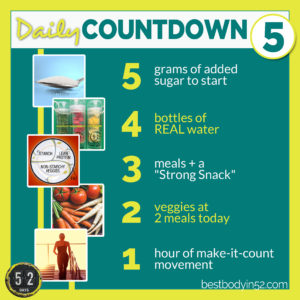Recently on a flight, I sat by a middle-aged woman with a dreamy smile on her face. She was traveling alone — heading somewhere exciting, I imagined. I was reading nutrition literature like I always do when I fly to conventions to present. The article I was studying caught her eye and she told me she was heading to the Biggest Loser Ranch for a week. I was a little surprised at her destination, considering the yearning expression I mentioned. She knew that many hours of daily, rigorous workouts were ahead of her, as well as extremely minimal meals. After chatting for a bit, I realized the smile was one of hope. Hope for a fresh start.
The show, The Biggest Loser, indeed brings hope and excitement to many viewers as they watch contestants transform completely — losing hundreds of pounds over about 6 months of intense workouts and tightly controlled diets. But do you ever wonder about how the next 6 months turn out for them, and the 6 months after that, or even the next 6 years?
I don’t wonder. I have worked as a dietitian and fitness pro for about 20 years, so I have watched the trend of outcomes first-hand. Now there is research out that confirms what I’ve observed over the many years I’ve worked in this fascinating, fad-filled industry. Too often I see that hope is held out for what turns out to be fleeting, and not without consequence.
Recently, a study was released that compares the initial outcomes of 14 men and women from the 2009 Biggest Loser season to their current status in terms of weight and metabolism. When the contestants concluded their made-for-TV regiment of exercising multiple hours a day, while eating dramatically less than their bodies required, they had lost an average of 128 pounds. Six years later, the research shows they have gained, as a group, an average of three-fourths of the weight back — and some have gained beyond where they started in 2009.
Weren’t they stronger post-training? Perhaps their muscle strength had increased, but metabolically, they were weakened. Metabolism regulates one’s calorie-burning efficacy throughout life. When contestants left the show, their resting metabolic rate (RMR) had decreased by about 24%. Six years later, researchers evaluated RMR again to learn it had not recovered. The once-enthusiastic contestants now have to work even harder to control their weight: a reduced metabolism as their unfortunate, ongoing parting-gift.
And what about their motivation, was it weakened as well? Instead of building local accountability and making step-by-step personal environment-based and lifestyle changes that would set them up for ongoing success, they were led to short-term victory by hype and an extreme regime that would be unrealistic to maintain once home.
The research suggests that extreme measures are not the route to lasting weight loss and overall well-being. (Even those who can hardly see past their class reunion weight goal don’t want a compromised metabolism six years down the road – having to work 24% harder just to burn the calories they would have naturally burned prior to engaging in such extremes).
As a registered dietitian who is often called in as the “cleanup crew” after the painful slide off the mountaintop insists its inevitability, I suggest “majoring on the majors” with persistence. Consistency is key with simple, realistic steps for those looking for lasting change – those who want to feel good in their skin and operate at their personal best.
My “lifelong strong” approach requires honest self-assessment and accountability, and trains participants to keep their eyes on the prize (rather than just the scale). The prize is enjoying life at one’s best: confident and energetic enough to get the most out of life and fulfill your greater purpose – not just calculate calories and each days’ weight gains and losses.

The goal of most dieters may simply be to look their best in their jeans, but over time, being one’s best also means feeling good about choices made daily and operating optimally at work and home, without suffering from the mental torment of unrealistic goals and the physical evidence of a compromised metabolism. I urge clients and readers of my two books to daily “count down” one good choice at a time until reaching their personal best. The definition of one’s “best” is different for everyone, and may change from one season of life to the next. It considers the balance of life’s best big-picture and doesn’t let one important aspect of well-being suffer on account of another.
 Focus on winning big, not just losing big! Winning is born of consistency. Challenge yourself to one or two of these “Countdown 5” strategies this week. Once you’ve been consistent with it for a week, add another. You will be amazed as to how great you look and feel when you are consistently doing each aspect of the “Countdown 5” simultaneously.
Focus on winning big, not just losing big! Winning is born of consistency. Challenge yourself to one or two of these “Countdown 5” strategies this week. Once you’ve been consistent with it for a week, add another. You will be amazed as to how great you look and feel when you are consistently doing each aspect of the “Countdown 5” simultaneously.
Your weight really will come off and stay off! If you need accountability (you will!), get a friend geared up to partner with you when my nation-wide Best Body Countdown begins (held nationally starting the Day after Labor Day in September, and the day after MLK in January every year).
If you are looking for hope, as was the woman on the plane, perhaps you’re thinking these small changes won’t be enough. If you just try them for a day or two, or just on Mondays and Tuesdays when the week starts afresh, you’re right – you won’t reach your destination.
The recipe for hope fulfilled is consistency + accountability + the daily, simple steps compiled in the Best Body Countdown. You can do it! There is hope! Don’t fall prey to unhealthy extremes which compromise your metabolism – you’ll want it to be in tip-top shape next year, too!
(Did I mention consistency? :))



